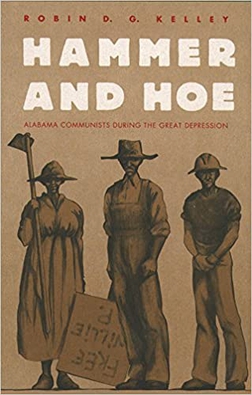Hammer and Hoe facts for kids

First edition book cover
|
|
| Author | Robin D. G. Kelley |
|---|---|
| Country | United States |
| Language | English |
| Subject | Labor history of the United States, Alabama, Communism, anti-racism |
| Genre | History |
| Publisher | University of North Carolina Press |
|
Publication date
|
1990 |
Hammer and Hoe: Alabama Communists during the Great Depression is an important history book from 1990. It was written by Robin D. G. Kelley. The book tells the story of workers, race, and society in Alabama during the Great Depression. This was a time in the 1930s when many people lost their jobs and money.
The book especially looks at how Black people organized using ideas from Communism. It shows how Black workers used their own ways of fighting unfairness. They mixed these traditions with new ideas to create their own kind of Marxism. Hammer and Hoe won several awards. A special edition was released in 2015 to celebrate its 25th anniversary.
Contents
How the Book Was Written
Robin D. G. Kelley wrote Hammer and Hoe while he was in graduate school. This was in the 1980s. It was a time when many people were involved in activism. Activism means working to bring about social or political change.
Robin Kelley's Inspiration
As a young activist, Kelley worked to make the University of California stop investing in South Africa. This was part of a movement against apartheid, a system of racial segregation. At the same time, he became interested in how Black people organized in the US. He especially studied the Communist Party in Alabama. This topic became his main research project. Later, it turned into the book Hammer and Hoe.
Publishing the Book
Kelley published Hammer and Hoe with the University of North Carolina Press in 1990. A special 25th anniversary edition came out in 2015. This new edition included an updated introduction from the author.
What the Book Is About
Hammer and Hoe explores the role of the Communist Party in fighting for racial equality in the southern United States. It focuses on Alabama, which was very segregated at the time. The book shows how the party worked for fair treatment in race, money, and politics.
Black Workers and Communism
Historians have praised Kelley's approach in the book. He didn't just ask if the Communist Party was "good." Instead, he explored how the party attracted many African-American workers in Alabama. He wanted to know how these workers used the Communist Party to organize themselves.
The book explains that Black workers in Alabama made communism their own. They combined the ideas of Marx and Lenin with their own traditions. These traditions came from the black church. They also came from years of fighting against slavery, segregation, and racist violence.


